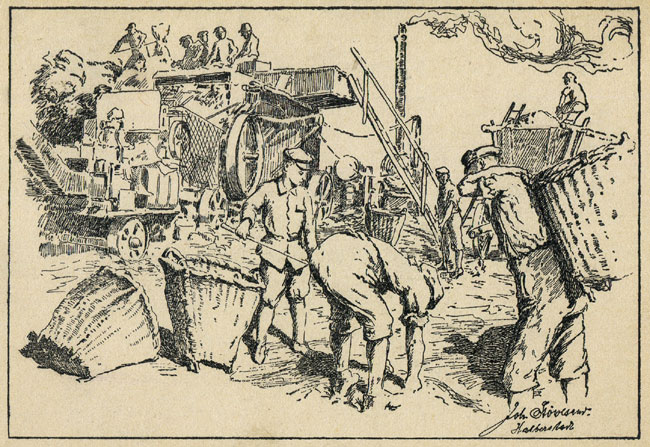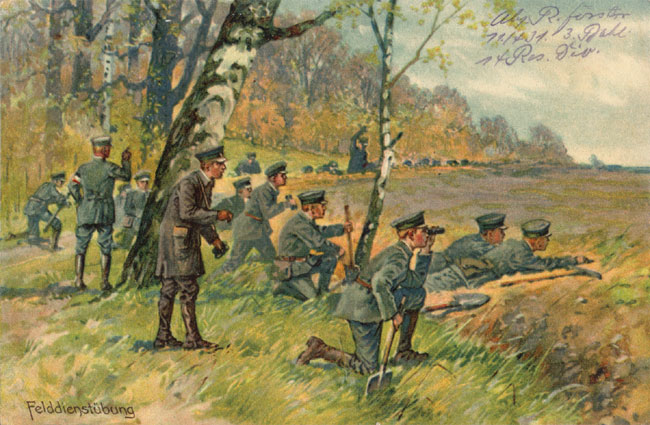As our friend Jan Vancoillie of WFA België has pointed out, the published history of Reserve-Infanterie-Regiment Nr.242 (53.RD / XXVII.RK) frankly admits that this regiment too had been accompanied by runaways when the corps left Germany in October 1914. Strikingly, one of them was allowed to make the transition from unofficial hanger-on to a full member of one of its fighting companies.
Joseph Rudolf Mogk (known as 'Sepp' or 'Seppl') was a sixteen-year-old orphan who was working as a 'lift boy' (at a hotel?) in Bad Nauheim before the war. He smuggled himself aboard the train of II. Batl. / RIR 242 on their war to the front, was caught on 13th October 1914 when they reached Würzburg and was emphatically forbidden from accompanying the unit. Strikingly, another two underage Pfadfinder were caught when the train reached Frankfurt-am-Main, and sent home by the Bahnhofskommandantur. However 'Sepp' had concealed himself under one of the battalion's baggage wagons and reappeared on arrival, when it was too late to send him back. The boy quickly made himself popular, entertaining the men with his witty remarks and showing a great talent for scrounging food and drink for them - which he continued to bring to them even in the front line. After a while he acquired a dog cart for his work, which was subsequently destroyed by an artillery hit which 'Sepp' himself barely escaped. In November he blagged a horse from a Flemish farmer, which soon disappeared too (sold according to him, stolen by artillerymen according to others).
Above: "Kingdom of Saxony: pupils from institutions of higher education in the Vaterländischer Hilfsdienst during the world war", a picture postcard sent through the civilian postal system in September 1918. The Vaterländischer Hilfsdienst was a mass mobilisation of civilian labour organised under the Hindenburg-Programm in December 1916. All males aged 17-60 and not already in military, agricultural or forestry service were henceforth expected to contribute towards the war economy.
In December 1914 'Sepp' was sent back to the regiment's designated training unit, the Ersatz-Bataillon of IR 102 in Bautzen. There he was trained as an infantryman, and joined 8. Komp. / RIR 242 in the field in March 1915. He was a popular and fearless but perpetually scruffy soldier, skilled at scrounging for his unit and at forward patrolling in No Man's Land. On 15th May he was awarded the Iron Cross (it doesn't say whether 1st or 2nd class in the source). In recognition of his achievement, it was decided that the regiment would pay for him to be apprenticed in a good trade after the war.
After the assault on Verlorenhoek on 24th May 1915, 'Sepp' went crawling out into No Man's Land on reconnaissance despite being expressly told not to do so. Despite his apparent belief in his own invincibility, he was shot dead. Initially buried in the regimental cemetery at the Passchendaele-Moorslede railway station, he now rests at Langemarck (grave B/14777).
Above: Saxon picture postcard mailed home in November 1916 by a member of the recently formed IR 431. Apparently part of a series portraying "unsere Jungmannschaften" (one of several variant names for local Jugendwehr groups), it depicts a well-organised field exercise. Though unarmed, the boys are fully uniformed in Feldgrau and equipped with digging tools, bread bags and a few pairs of binoculars.
Two brief mentions of runaway 'volunteers' with XXVII. Reservekorps appear in the Korpstagesbefehle (corps orders of the day). A large collection of these fascinating documents is preserved at the Saxon archives in Dresden, providing unexpected insight into numerous aspects of daily operations on and behind the Flanders front. The numerous announcements in the Korpstagesbefehl for 21st November 1914 include the following:
The schoolboy Karl Tillack von Reibersdorf near Zittau in Saxony has been missing since 7th October. His parents suspect that he has taken himself off to the Western theatre of war in a state of martial enthusiasm. If he is found, his father (Karl Tillack, Reibersdorf) is to be notified. Description: 14 years old, blond, grey-blue eyes, Saxon dialect; on the way he was wearing a green school cap, brown ??? trousers, grey winter overcoat.
The Korpstagesbefehl of 11th December 1914 contains this revealing appeal:
Two 14 to 16-year-old German boys have early this morning betaken themselves from Dadizeele, probably to troops at the front. These [boys] come from Aachen and belong to the Aachen Jugendwehr. One of them is wearing a kind of Litewka [undress uniform jacket] with red facings on the collar and plain buttons with a round slouch hat, the other wears the attire of the Jugendwehr with insignia on the arm and cap. If encountered by the troops, the two boys are immediately to be brought to the Generalkommando [corps HQ] in Dadizeele.
This seems to imply that members of the Aachen Jugendwehr were present in an authorised capacity in the corps HQ village of Dadizele - conceivably there were other members of the party beyond these two who went on a jaunt to the trenches. Given the proximity of Aachen to the Belgian border, the organised presence of their Jugendwehr in occupied Belgium (though not so far westward!) is perhaps not so surprising.
I found no further announcements of this kind among the numerous Korpstagesbefehle I skimmed through, running from October 1914 up to late 1915. Given the apparent scale of the phenomenon in RIR 245 alone, this is quite surprising.
We would greatly appreciate reports of any other sources on 'irregular volunteers' of this kind in the Royal Saxon Army, and most especially in RIR 245. The brief celebrity of Fritz Lehmann alone must have generated considerably more coverage than the few scraps we have been able to unearth!
- << Prev
- Next







